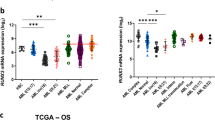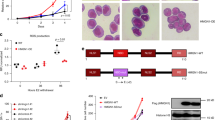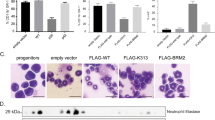Abstract
Correct hematopoietic differentiation requires the tightly regulated execution of lineage-specific and stage-restricted gene expression programs. This process is disturbed in hematological malignancies that typically show incomplete differentiation but often also display a mixed lineage phenotype. Co-expression of lymphoid and myeloid molecules is a well-known feature of acute myeloblastic leukemia (AML) with t(8;21). These cells consistently express the B-cell-specific transcription factor PAX5, and the B-cell-specific cell surface protein CD19. However, the functional consequences of PAX5 expression are unknown. To address this question, we studied the chromatin features of CD19, which is a direct target of PAX5 in cells with and without the t(8;21) chromosomal translocation. We show that CD19 chromatin exists in a poised configuration in myeloid progenitors and that this poised chromatin structure facilitates PAX5-dependent CD19 activation. Our results also show a positive correlation between PAX5 and CD19 expression in t(8;21)-positive AML cells and demonstrate that PAX5 binds to the promoter and enhancer of CD19 gene and remodels chromatin structure at the promoter. This study shows that expression of PAX5 in leukemic cells has functional consequences and points to an important role of a progenitor-specific chromatin configuration in myeloid leukemia.
This is a preview of subscription content, access via your institution
Access options
Subscribe to this journal
Receive 50 print issues and online access
$259.00 per year
only $5.18 per issue
Buy this article
- Purchase on Springer Link
- Instant access to full article PDF
Prices may be subject to local taxes which are calculated during checkout







Similar content being viewed by others
References
Amann JM, Nip J, Strom DK, Lutterbach B, Harada H, Lenny N et al. (2001). ETO, a target of t(8;21) in acute leukemia, makes distinct contacts with multiple histone deacetylases and binds mSin3A through its oligomerization domain. Mol Cell Biol 21: 6470–6483.
Attema JL, Papathanasiou P, Forsberg EC, Xu J, Smale ST, Weissman IL . (2007). Epigenetic characterization of hematopoietic stem cell differentiation using miniChIP and bisulfite sequencing analysis. Proc Natl Acad Sci USA 104: 12371–12376.
Berg T, Fliegauf M, Burger J, Staege MS, Liu S, Martinez N et al. (2008). Transcriptional upregulation of p21/WAF/Cip1 in myeloid leukemic blasts expressing AML1-ETO. Haematologica 93: 1728–1733.
Bonifer C . (2005). Epigenetic plasticity of hematopoietic cells. Cell Cycle 4: 211–214.
Cobaleda C, Schebesta A, Delogu A, Busslinger M . (2007). Pax5: the guardian of B cell identity and function. Nat Immunol 8: 463–470.
Decker T, Pasca di Magliano M, McManus S, Sun Q, Bonifer C, Tagoh H et al. (2009). Stepwise activation of enhancer and promoter regions of the B cell commitment gene Pax5 in early lymphopoiesis. Immunity 30: 508–520.
Drexler HG, Thiel E, Ludwig WD . (1991). Review of the incidence and clinical relevance of myeloid antigen-positive acute lymphoblastic leukemia. Leukemia 5: 637–645.
Drexler HG, Thiel E, Ludwig WD . (1993). Acute myeloid leukemias expressing lymphoid-associated antigens: diagnostic incidence and prognostic significance. Leukemia 7: 489–498.
Elagib KE, Goldfarb AN . (2007). Oncogenic pathways of AML1-ETO in acute myeloid leukemia: multifaceted manipulation of marrow maturation. Cancer Lett 251: 179–186.
Follows GA, Tagoh H, Lefevre P, Hodge D, Morgan GJ, Bonifer C . (2003). Epigenetic consequences of AML1-ETO action at the human c-FMS locus. EMBO J 22: 2798–2809.
Gibson SE, Dong HY, Advani AS, Hsi ED . (2006). Expression of the B cell-associated transcription factors PAX5, OCT-2, and BOB.1 in acute myeloid leukemia: associations with B-cell antigen expression and myelomonocytic maturation. Am J Clin Pathol 126: 916–924.
Graf T . (2002). Differentiation plasticity of hematopoietic cells. Blood 99: 3089–3101.
Kagoshima H, Shigesada K, Satake M, Ito Y, Miyoshi H, Ohki M et al. (1993). The Runt domain identifies a new family of heteromeric transcriptional regulators. Trends Genet 9: 338–341.
Kita K, Nakase K, Miwa H, Masuya M, Nishii K, Morita N et al. (1992). Phenotypical characteristics of acute myelocytic leukemia associated with the t(8;21)(q22;q22) chromosomal abnormality: frequent expression of immature B-cell antigen CD19 together with stem cell antigen CD34. Blood 80: 470–477.
Kohler C, Villar CB . (2008). Programming of gene expression by Polycomb group proteins. Trends Cell Biol 18: 236–243.
Kondo M, Scherer DC, Miyamoto T, King AG, Akashi K, Sugamura K et al. (2000). Cell-fate conversion of lymphoid-committed progenitors by instructive actions of cytokines. Nature 407: 383–386.
Kozmik Z, Wang S, Dorfler P, Adams B, Busslinger M . (1992). The promoter of the CD19 gene is a target for the B-cell-specific transcription factor BSAP. Mol Cell Biol 12: 2662–2672.
Kwon K, Hutter C, Sun Q, Bilic I, Cobaleda C, Malin S et al. (2008). Instructive role of the transcription factor E2A in early B lymphopoiesis and germinal center B cell development. Immunity 28: 751–762.
Lefevre P, Lacroix C, Tagoh H, Hoogenkamp M, Melnik S, Ingram R et al. (2005). Differentiation-dependent alterations in histone methylation and chromatin architecture at the inducible chicken lysozyme gene. J Biol Chem 280: 27552–27560.
Linggi B, Muller-Tidow C, van de Locht L, Hu M, Nip J, Serve H et al. (2002). The t(8;21) fusion protein, AML1 ETO, specifically represses the transcription of the p14(ARF) tumor suppressor in acute myeloid leukemia. Nat Med 8: 743–750.
Matozaki S, Nakagawa T, Kawaguchi R, Aozaki R, Tsutsumi M, Murayama T et al. (1995). Establishment of a myeloid leukaemic cell line (SKNO-1) from a patient with t(8;21) who acquired monosomy 17 during disease progression. Br J Haematol 89: 805–811.
Mikhail FM, Serry KA, Hatem N, Mourad ZI, Farawela HM, El Kaffash DM et al. (2002). A new translocation that rearranges the AML1 gene in a patient with T-cell acute lymphoblastic leukemia. Cancer Genet Cytogenet 135: 96–100.
Miyamoto T, Nagafuji K, Akashi K, Harada M, Kyo T, Akashi T et al. (1996). Persistence of multipotent progenitors expressing AML1/ETO transcripts in long-term remission patients with t(8;21) acute myelogenous leukemia. Blood 87: 4789–4796.
Miyamoto T, Weissman IL, Akashi K . (2000). AML1/ETO-expressing nonleukemic stem cells in acute myelogenous leukemia with 8;21 chromosomal translocation. Proc Natl Acad Sci USA 97: 7521–7526.
Moreau T, Bardin F, Imbert J, Chabannon C, Tonnelle C . (2004). Restriction of transgene expression to the B-lymphoid progeny of human lentivirally transduced CD34+ cells. Mol Ther 10: 45–56.
Mulloy JC, Jankovic V, Wunderlich M, Delwel R, Cammenga J, Krejci O et al. (2005). AML1-ETO fusion protein up-regulates TRKA mRNA expression in human CD34+ cells, allowing nerve growth factor-induced expansion. Proc Natl Acad Sci USA 102: 4016–4021.
Nishida S, Hosen N, Shirakata T, Kanato K, Yanagihara M, Nakatsuka S et al. (2006). AML1-ETO rapidly induces acute myeloblastic leukemia in cooperation with the Wilms tumor gene, WT1. Blood 107: 3303–3312.
Nutt SL, Heavey B, Rolink AG, Busslinger M . (1999). Commitment to the B-lymphoid lineage depends on the transcription factor Pax5. Nature 401: 556–562.
Nutt SL, Morrison AM, Dorfler P, Rolink A, Busslinger M . (1998). Identification of BSAP (Pax-5) target genes in early B-cell development by loss- and gain-of-function experiments. EMBO J 17: 2319–2333.
Okuda T, van Deursen J, Hiebert SW, Grosveld G, Downing JR . (1996). AML1, the target of multiple chromosomal translocations in human leukemia, is essential for normal fetal liver hematopoiesis. Cell 84: 321–330.
Ooi SK, Qiu C, Bernstein E, Li K, Jia D, Yang Z et al. (2007). DNMT3L connects unmethylated lysine 4 of histone H3 to de novo methylation of DNA. Nature 448: 714–717.
Orford K, Kharchenko P, Lai W, Dao MC, Worhunsky DJ, Ferro A et al. (2008). Differential H3K4 methylation identifies developmentally poised hematopoietic genes. Dev Cell 14: 798–809.
Pabst T, Mueller BU, Harakawa N, Schoch C, Haferlach T, Behre G et al. (2001). AML1-ETO downregulates the granulocytic differentiation factor C/EBPalpha in t(8;21) myeloid leukemia. Nat Med 7: 444–451.
Peterson LF, Boyapati A, Ahn EY, Biggs JR, Okumura AJ, Lo MC et al. (2007a). Acute myeloid leukemia with the 8q22;21q22 translocation: secondary mutational events and alternative t(8;21) transcripts. Blood 110: 799–805.
Peterson LF, Wang Y, Lo MC, Yan M, Kanbe E, Zhang DE . (2007b). The multi-functional cellular adhesion molecule CD44 is regulated by the 8;21 chromosomal translocation. Leukemia 21: 2010–2019.
Reading CL, Estey EH, Huh YO, Claxton DF, Sanchez G, Terstappen LW et al. (1993). Expression of unusual immunophenotype combinations in acute myelogenous leukemia. Blood 81: 3083–3090.
Roessler S, Gyory I, Imhof S, Spivakov M, Williams RR, Busslinger M et al. (2007). Distinct promoters mediate the regulation of Ebf1 gene expression by interleukin-7 and Pax5. Mol Cell Biol 27: 579–594.
Schessl C, Rawat VP, Cusan M, Deshpande A, Kohl TM, Rosten PM et al. (2005). The AML1-ETO fusion gene and the FLT3 length mutation collaborate in inducing acute leukemia in mice. J Clin Invest 115: 2159–2168.
Schreiber E, Matthias P, Muller MM, Schaffner W . (1989). Rapid detection of octamer binding proteins with ‘mini-extracts’, prepared from a small number of cells. Nucleic Acids Res 17: 6419.
Seet CS, Brumbaugh RL, Kee BL . (2004). Early B cell factor promotes B lymphopoiesis with reduced interleukin 7 responsiveness in the absence of E2A. J Exp Med 199: 1689–1700.
Speck NA, Gilliland DG . (2002). Core-binding factors in haematopoiesis and leukaemia. Nat Rev Cancer 2: 502–513.
Tagoh H, Ingram R, Wilson N, Salvagiotto G, Warren AJ, Clarke D et al. (2006). The mechanism of repression of the myeloid-specific c-fms gene by Pax5 during B lineage restriction. EMBO J 25: 1070–1080.
Tagoh H, Schebesta A, Lefevre P, Wilson N, Hume D, Busslinger M et al. (2004). Epigenetic silencing of the c-fms locus during B-lymphopoiesis occurs in discrete steps and is reversible. EMBO J 23: 4275–4285.
Tiacci E, Pileri S, Orleth A, Pacini R, Tabarrini A, Frenguelli F et al. (2004). PAX5 expression in acute leukemias: higher B-lineage specificity than CD79a and selective association with t(8;21)-acute myelogenous leukemia. Cancer Res 64: 7399–7404.
Tonks A, Pearn L, Musson M, Gilkes A, Mills KI, Burnett AK et al. (2007). Transcriptional dysregulation mediated by RUNX1-RUNX1T1 in normal human progenitor cells and in acute myeloid leukaemia. Leukemia 21: 2495–2505.
Valbuena JR, Medeiros LJ, Rassidakis GZ, Hao S, Wu CD, Chen L et al. (2006). Expression of B cell-specific activator protein/PAX5 in acute myeloid leukemia with t(8;21)(q22;q22). Am J Clin Pathol 126: 235–240.
Walter K, Bonifer C, Tagoh H . (2008). Stem cell-specific epigenetic priming and B cell-specific transcriptional activation at the mouse Cd19 locus. Blood 112: 1673–1682.
Wang Q, Stacy T, Binder M, Marin-Padilla M, Sharpe AH, Speck NA . (1996). Disruption of the Cbfa2 gene causes necrosis and hemorrhaging in the central nervous system and blocks definitive hematopoiesis. Proc Natl Acad Sci USA 93: 3444–3449.
Xie H, Ye M, Feng R, Graf T . (2004). Stepwise reprogramming of B cells into macrophages. Cell 117: 663–676.
Acknowledgements
We thank M Busslinger for providing reagents including antibodies and plasmids and S Valeaux and A Ebert for technical assistance. This work was supported by Leukaemia & Lymphoma Research and by the Kay Kendall Leukaemia Fund. HT holds a Research Council UK academic fellowship.
Author information
Authors and Affiliations
Corresponding author
Ethics declarations
Competing interests
The authors declare no conflict of interest.
Additional information
Supplementary Information accompanies the paper on the Oncogene website
Supplementary information
Rights and permissions
About this article
Cite this article
Walter, K., Cockerill, P., Barlow, R. et al. Aberrant expression of CD19 in AML with t(8;21) involves a poised chromatin structure and PAX5. Oncogene 29, 2927–2937 (2010). https://doi.org/10.1038/onc.2010.56
Received:
Revised:
Accepted:
Published:
Issue Date:
DOI: https://doi.org/10.1038/onc.2010.56
Keywords
This article is cited by
-
RUNX1 mutations in blast-phase chronic myeloid leukemia associate with distinct phenotypes, transcriptional profiles, and drug responses
Leukemia (2021)
-
Mixed Phenotype Acute Leukemia: Current Approaches to Diagnosis and Treatment
Current Oncology Reports (2021)
-
Indications to Epigenetic Dysfunction in the Pathogenesis of Common Variable Immunodeficiency
Archivum Immunologiae et Therapiae Experimentalis (2017)
-
PAX genes in childhood oncogenesis: developmental biology gone awry?
Oncogene (2015)
-
Molecular characterization and testing in acute myeloid leukemia
Journal of Hematopathology (2015)



